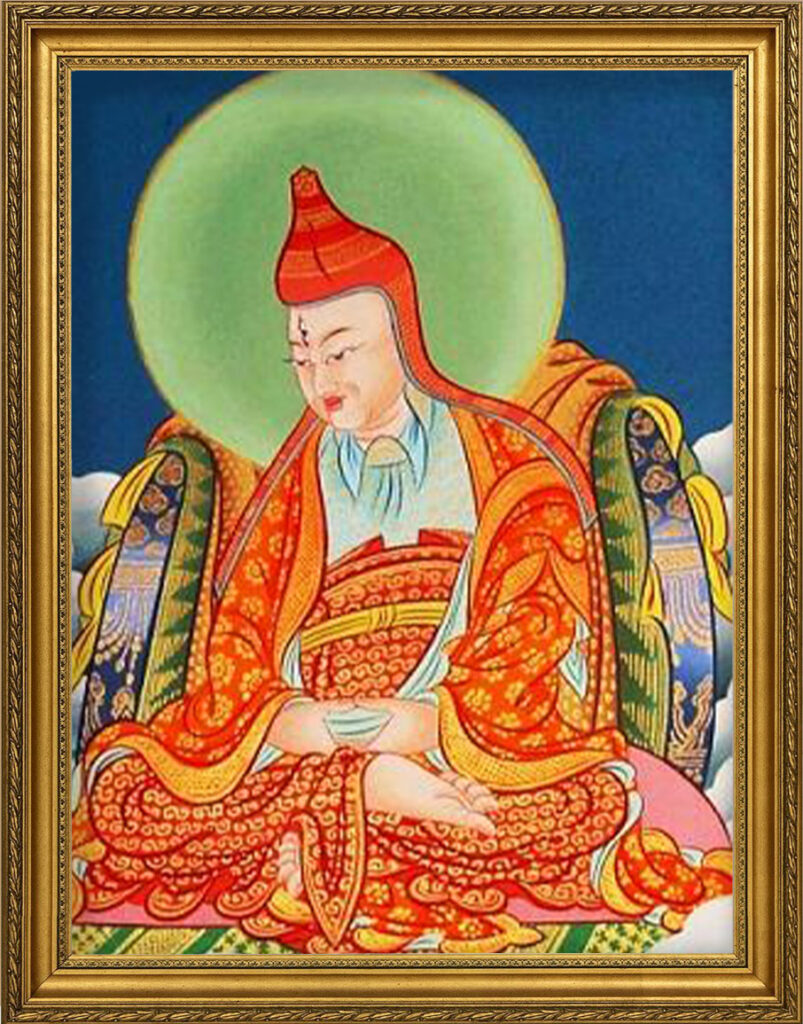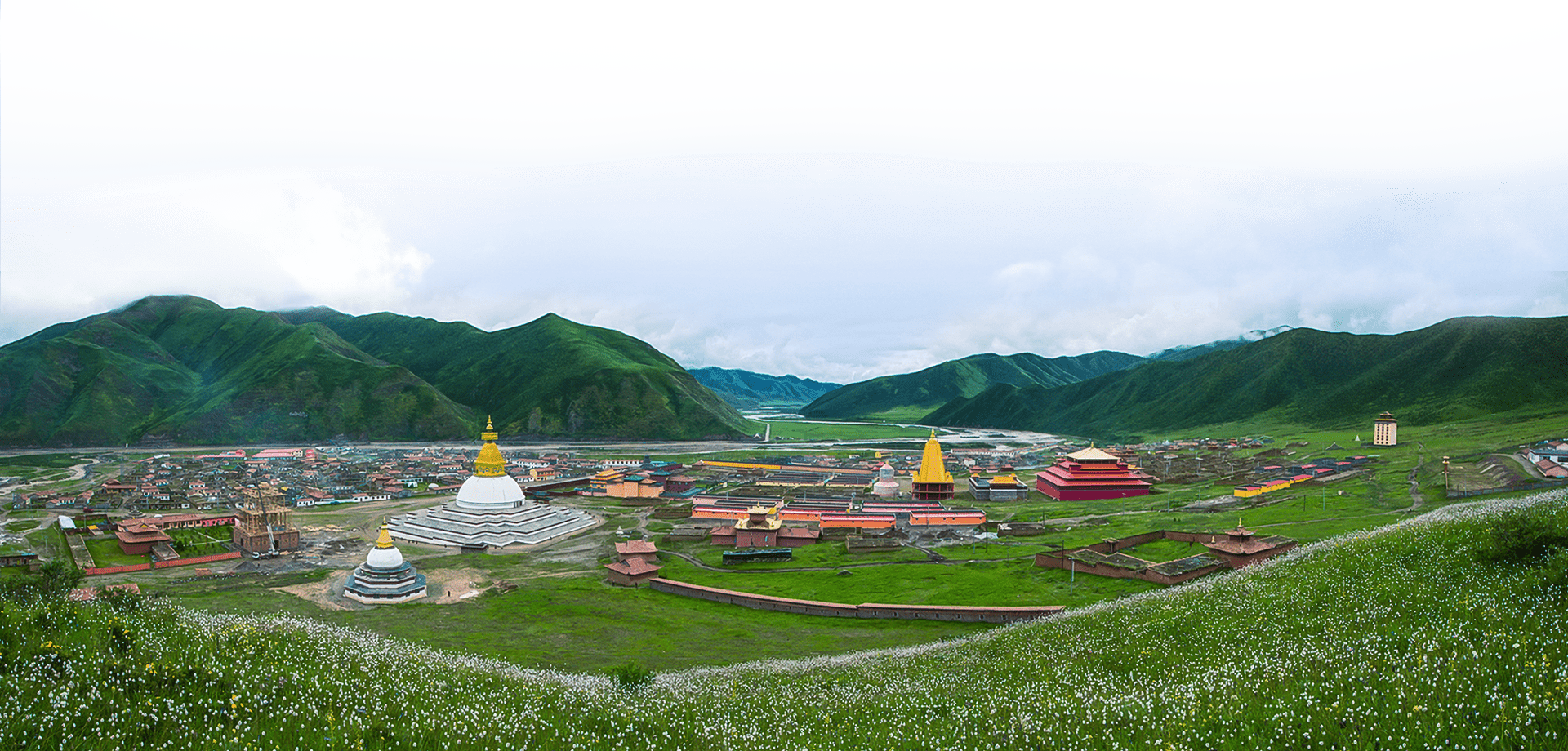Vairochana
Vairochana was the foremost translator of Buddhist scriptures in Tibetan history. He was responsible for bringing to Tibet and translating many sūtras and tantras, especially two of the three categories of Dzogpa Chenpo teachings, namely Semde and Longde. He was born at Nyemo Chekhar in Tsang Province as the son of Dorje Gyalpo of the Pakor clan. In his childhood he displayed many miraculous powers such as flying in the sky, making imprints on rocks, and foretelling future events. He was extraordinarily intelligent. In accordance with the prophetic advice of Guru Rinpoche, King Trisong Detsen brought him to Samye and trained him as a translator. He became one of the first seven Tibetans to take monastic vows from Shāntarakṣhita and was given the name Vairochanarakṣhita. In the empowerment of the great sādhana of eight maṇḍalas, his flower landed on the maṇḍala of Möpa Tra-ngak (Vajramentrabhīru). At the command of the king, Vairochana and the monk Lektrup of Tsang Province went to India in search of Dharma teachings, as two of the first missionaries. On the way they encountered fifty-seven nearly fatal difficulties, but they ignored the obstacles and reached India. They met Shrīsiṃha in secret at the forest of Tsenden Silche in Dhanakosha. One night they received the teachings of Semde in utmost secret. Vairochana wrote down the eighteen tantras of Semde on white cotton with the milk of a white cow in order that people should not see the texts. When he wanted the manuscript to be read, he held it over smoke and the text became visible. The monk Lektrup was satisfied with what they had accomplished and departed for Tibet. On the way back he was killed by road guards.
Vairochana requested more teachings from Shrīsiṃha, and he received the teachings and instructions of all the sixty tantras of Semde. He was also taught the three categories of Longde. Vairochana also received the teachings of the six million four hundred thousand tantras (or verses) of Dzogpa Chenpo from Prahevajra in pure vision and blessings from master Mañjushrīmitra in his ilusory- wisdom-body.
Vairochana reached Tibet by swift-footed power, and there he gave the king common teachings in the daytime and Dzogpa Chenpo at night. Among other works, he translated the first five of the eighteen tantras of Semde. This collection is known as The Five Early Translations of Semde.
At that time some jealous Indians sent messengers to spread slander, saying that the teachings brought from India by Vairochana were not Buddhism. Because of the wrong aspirations and influence of Queen Tsepongza and certain wicked ministers, the king was forced regretfully to banish Vairochana to the Gyalmo Tsawe Rong (aka Gyarong), a region on the border of Tibet and China. In exile, Vairochana converted the king, his ministers and the population of Gyarong to Buddhism. Prince Yudra Nyingpo, who was the rebirth of the monk Lekrup of Tsang, became one of his principal disciples and a well-known scholar and lineage-holder. Yudra Nyingpo came to Samye and met Vimalamitra. At Vimalamitra’s request the king invited Vairochana to return to Tibet. On the way to Tibet, Vairochana met an eighty-five-year-old man named Mipham Gönpo, and he gave him Dzogpa Chenpo teachings. Mipham Gönpo could not sit in meditation postures because of his advanced age, so he had recourse to a meditation cord and support stick in order to sit up straight and remain motionless. The old man attained the rainbow body.
In addition to Yudra Nyingpo and Mipham Gönpo, the principal disciples of Vairochana were Nyak Jñānakumāra and Sherap Dölma from Li. Later on Sherap Dölma invited his master to the country of Li. From there Vairochana went to the Bhashing forest of Nepal, where he vanished into the rainbow body.
Vairochana is the sublime translator of Tibetan Buddhism. He translated many texts of sūtra and tantra, and his scholarship and skill as a translator are far more exalted than those of all the other translators in the history of Tibetan Buddhism. Ngok Loden Sherap (1059–1109), who was one of the greatest translators of the new translation period, said:
Vairochana is like the clear sky.
Ka[wa Paltsek] and Chok[ro Lü’i Gyaltsen] are like the sun and moon.
Rinchen Zangpo [958–1051, the greatest translator of the new period] is like the dawn star.
And we are merely fireflies.
Among his numerous incarnations were Trapa Ngönshechen (1012–1090?), Dorje Lingpa (1346–1405), Künkyong Lingpa (1396–1477?), Chöden Do-ngak Lingpa (15th century), Trengpo Sherap Özer (1518–1572), Minling Terchen (1646–1714), Rongtön Dechen Lingpa (1663–?), Gyalse Zhenphen Thaye (1800–?) and Kongtrül Yönten Gyatso (1813–1899).
Tulku Thondup
“Masters of Meditation and Miracles: Lives of the Great Buddhist Masters of India and Tibet”










